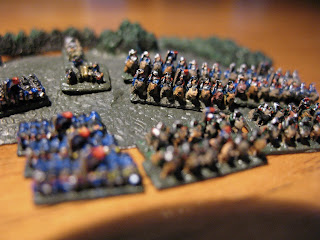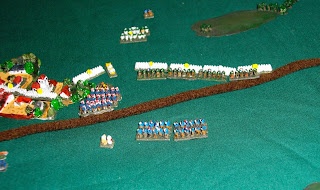 |
French 9e cuirassiers at two scales.
|
A few comments on my recent 'update' post lead me to check when I first purchased some 2 mm figures. It was back in the mid-2000s. I think that I was looking at Irregular Miniature's website and happened to click on the 2 mm section. "What a marvellous idea", I thought. Wouldn't it be fun to set up a wargame at such a small scale, perhaps even on the tray at the back of an aeroplane seat?!So, I duly ordered a few figures (French and Austrian army packs) to see them up close and what I could make of them. I liked them immediately. I was astounded at the amount of
detail on something so small and also the huge scope for interpretation
and adaptability of the figures.
Some photos below taken by my non-wargaming, but camera savvy friend Chris G. showing how amazing these little fellas are.
 |
| Photos to illustrate that they can look like something (c/- Chris G.; finger and pencil for scale). |
A couple of years or so later I had sufficient figures painted, or somewhat painted, to try out a game. I had found a free set called "2 by 2 Napoleonics" on the web and Stephen N. was interested (crazy) enough to have a go.
Below are some low-resolution photos of the first try with 2 x 2 Napoleonics in May 2008. You'll see from the photos and those that follow (all c/- Stephen) that I was using the bases 'as was', stuck in my paradigm of battalion/regimental scale.
 |
First game of 2 by 2 Napoleonics
|
 |
| Fiddly to handle as single playing pieces. |
Despite the fiddliness, we both had a bit of fun and so were prepared to try them again. Two more games followed, in June 2008 and April 2009. I had added a bit more terrain and a few more figures as we went along. We adapted and adjusted the rules to try to make them work better but, in the end, decided that they were not up to scratch. There was a pause in the 2 mm 'experiment'.
 |
Second game of 2 by 2 Napoleonics; now with felt roads, fields and rivers!
|
 |
| Still using single playing pieces. |
 |
| Third game, now on felt mat. |
Further thinking, discussions and
exposure to Baccus' Polemos rules (ostensibly for 6 mm figures) brought
me to basing as a regiment, brigade or division, which I duly did. Other projects and activities took precedence, so the 2 mm figures remained incomplete, with only a few French ready for use.
Below are some photos of my completed French in 2011 based as larger formations.
 |
| The French re-based ostensibly as regiments, but easily scaled to brigades or divisions. |
 |
| Left to right: two line infantry regiments and a légère to right |
 |
| Left to right: the two line infantry regiments and légère with artillery battery and limbers to right |
 |
Left to right: those 9e cuirassiers again, Polish Guard lancers, then line chasseurs.
|
 |
Left to right: the Polish Guard lancers and line chasseurs once more with 5e hussars at right.
|
Advance
another few years and they are back, 'bigger' than ever, as part of my
desire to work at multiple scales, hopefully 'concurrently'. I have a
sizeable Austrian force in my painting sights and, once they are done, there are some part-completed French to add to that force. I am flexible in how I consider my bases (regiments, brigades or divisions) for painting any little details/colour on the figures. The scale affords plenty of latitude!



























Have you ever considered the Kriegspiele rules for this scale?
ReplyDeleteThe short answer is 'no'. The longer answer is 'hmmmmm'. I only know of kriegspiele as the German high command's simulation, particularly ahead of the failed implementation of the Schlieffen plan and the role of the approach in the origins of the hobby. On reflecting on your your question further, the idea of a more fluid, qualitative, descriptive approach may well be something for me to add to the list. Especially since I am moving more and more to this as a simulation/exploration of history and far less of a game with other players and dice (not that I'd exclude the latter). I did a quick search and there is a dedicated website and 'resources' (a version for sale too?). Worth looking at more for me. Thanks for sowing that seed Joe.
DeleteI only mention it as I have recently purchased a copy and on first read through am intrigued. Being an old red leg LT, these might be a good solo or even up to small group game.
DeleteYour close-up photos look amazing.
ReplyDeleteThanks Jonathan. The real effect of these is/will be en-masse, but there is something when you look closely (even if you do need to take a somewhat abstract perspective!).
DeleteVery cool gaming in 2mm!
ReplyDeleteThank you Dean. Most of the game aspect is yet to come.
DeleteThey look good en masse. I like your regimental bases. Polemos would work very well.
ReplyDelete2mm for grand tactical, 20-28mm for detachments, 54mm for skirmishes?
Yes, that's the general approach.
DeleteMy specifics will be a little different and adaptable, so I can see 2 mm from entire battle 'front'/campaign down to brigade/divisional scale, 54 mm for brigade level (e.g. Napoleon's Battles and Volley and Bayonet) but also for a bigger visual effect at battalion level, while my main scale (20 mm-1/72-25 mm in my case) can be applied for actions from battalion to multi-corps. The lowest level for me is a few battalions (so a section of a battle or a small action, e.g. with Chef de Bataillon). Skirmish actions with individual figures do not grab me for Napoleonics.
I did not like the Polemos rules for Napoleonics (a bit of the 18th century in there, so better suited for that, was what I/we concluded), but the overall mechanic (especially tempo) and the basing and flexibility of scale are excellent aspects that have influenced me.
Cheers, James
Nice work James, and 2mm really does give the impression of a Napoleonic battle in grand scale.
ReplyDeleteThank you Lawrence. I should be able to have some photos of them doing just that in the not too distant!
DeleteI certainly see the benefit of the smaller scale but I think these are a bit too small for my liking. It really depends on which facet of the hobby gives you the most pleasure...I tend towards the painting and aesthetics end of the scale...I think even if I could never have another game, I would stil enjoy collecting and painting figures!
ReplyDeleteI understand your point completely Keith. For me the order is history first and foremost (esp. books), collecting and painting the figures second and then games last. I don't think that I'd want the 2 mm to be the only figures that I had. They are very much in addition to my main scale of 20 mm-1/72-25 mm. Mind you, there is a lot of fun and satisfaction in painting them (as I mentioned in the post).
DeleteVery nice, Curt (at Analogue hobbies) and Sydney Roundwood have done so.e very nice 2mm formations and it gives you great scope for wonderful terrain, it seems like you need to be a bit more impressionistic in your painting?
ReplyDeleteBest Iain
Thanks Iain. Yes, I have seen the lovely examples on those two blogs. Marvellous.
ReplyDeleteThe 'impressionistic' aspect is part of the appeal. It's amazing how you can 'see' a pelisse on a figure or not, as the need arises!
Wow, very very impressive scale!
ReplyDeleteThanks Phil. Not as impressive as what you Riflemens do though!
DeleteI don't think my eyesight could handle this scale but the big bases make a difference and helps visually. I think the terrain will be a key factor with this scale and bring it all to life.
ReplyDeleteI missed this earlier. 2 mm are definitely too small for me, but I can certainly see the potential appeal and uses.
ReplyDelete